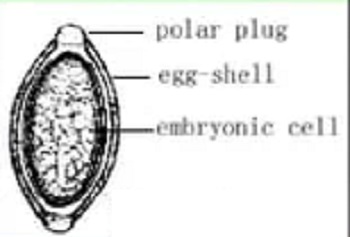Trichuris trichiura - Introduction, Classification, History, Habitat, Morphology, Life Cycle
Introduction to Trichuris trichiura
Trichuris trichiura, commonly known as whipworm, is a helminth parasite that causes trichinosis in humans. This intestinal infection occurs due to the invasion of the mucosa of the colon by the adult parasite.
The name whipworm is derived from its characteristic ship-like shape i.e. it resembles a whip with wider “handles” at its posterior end.
The parasitic roundworm is scientifically also known as Trichocephalus trichiurus.
History of Trichuris trichiura
Historically, Trichuris trichiura was first described in 1771 by Linnaeus.
Habitat of Trichuris trichiura
Trichuris trichiura is a common intestinal parasite in humans. The adult worm inhabits the large intestine, primarily in the caecum and the appendix and less commonly in the host rectum.
Morphology of Trichuris trichiura
The morphological feature of Trichuris trichiura is its relatively smaller size and the lack of tissue migration phase in its life cycle.
The parasite’s morphological stages include – adult (male, female), and eggs.

Figure: adult female (a) and male (b) Trichuris trichiura (Source: Jotscroll)
Adult worm
adult worm of Trichuris trichiura is whip-shaped
pinkish-white in color
three-fifth part of the anterior end is long, thin and hair-like
posterior one-to-two fifth part is short, thick, and stout
whipworm remains attached to the intestinal mucosa with the help of their anterior end
the anterior end is deeply embedded into the mucosa
presence of an esophagus
the anterior end of the intestine has a column of large secretory cells
the posterior end has reproductive organs
Male
male Trichuris trichiura measures 30 mm to 40 mm in length
recognized by characteristic coiled posterior end
Female
female Trichuris trichiura measures 40 mm to 50 mm in length i.e. longer than make
blunt posterior end
oviparous
each female lays 5000-7000 eggs in a day
has a life-span of many years

Figure: Trichuris trichiura egg (Source: Slide Share)
Egg
Trichuris trichiura eggs are barrel-shaped
measures 50 μm to 54 μm in length and 22 μm to 23 μm in breadth
has a colorless protruding mucus plug at each end
yellowish brown with a double shell
the outer shell is bile-stained while the inner shell is not
floats in saturated salt solution
when passed in the host feces, eggs contain an unsegmented ovum each
the freshly passed stool is not infective to humans
Life Cycle of Trichuris trichiura
The life cycle of Trichuris trichiura is simple i.e. it is completed in a single host. Unlike Ascaris and hookworm, this parasite has no tissue migratory phase. However, for its life cycle to be complete, a change of host is necessary.
Humans acquire Trichuris trichiura infection after ingesting soil containing embryonated eggs
these embryonated eggs hatch in the intestine to release larvae
the larvae penetrate the villi where they continue to develop
after 7 days, these young Trichuris trichiura leave the small intestine and reaches the caecum where they sexually mature into male and female adults
following fertilization, the female adult begins laying fertilized eggs
* the time between infection by Trichuris trichiura and laying eggs is about 3 months
these unembryonated eggs are excreted out with the host's feces
each adult female can lay about 5,000 to 7,000 eggs per day for around 5 years
after the eggs present in the host feces reaches damp warm soil, further development of eggs takes place
within 10 to 14 days, these eggs develop into embryonated eggs – each containing a rhabditiform larva
* Only such embryonated eggs are infectious to humans while freshly laid unembryonated eggs cannot cause infection
in moist soil, the embryonated eggs can remain viable/infective for several months
if these embryonated eggs are consumed by other human hosts, transmission occurs and the life cycle of Trichuris trichiura is completed

Figure: Trichuris trichiura life-cycle (Source: CDC)